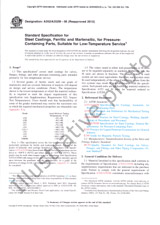We need your consent to use the individual data so that you can see information about your interests, among other things. Click "OK" to give your consent.
ASTM E408-13(2019)
Standard Test Methods for Total Normal Emittance of Surfaces Using Inspection-Meter Techniques
Translate name
STANDARD published on 1.10.2019
The information about the standard:
Designation standards: ASTM E408-13(2019)
Note: WITHDRAWN
Publication date standards: 1.10.2019
SKU: NS-972595
The number of pages: 5
Approximate weight : 15 g (0.03 lbs)
Country: American technical standard
Category: Technical standards ASTM
The category - similar standards:
Annotation of standard text ASTM E408-13(2019) :
Keywords:
emittance, infrared emittance, material radiative property, normal emittance, radiative heat transfer, spacecraft thermal control, thermal radiation ,, ICS Number Code 17.040.20 (Properties of surfaces)
Additional information
| 1. Scope | ||||||||||||||||||||||||
|
1.1 These test methods cover determination of the total normal emittance (Note 1) of surfaces by means of portable, as well as desktop, inspection-meter instruments. Note 1: Total normal emittance (εN) is defined as the ratio of the
normal radiance of a specimen to that of a blackbody radiator at
the same temperature. The equation relating εN to wavelength and spectral
normal emittance [εN(λ)] is
1.2 These test methods are intended for measurements on large surfaces, or small samples, or both, when rapid measurements must be made and where a nondestructive test is desired. They are particularly useful for production control tests. 1.3 This standard does not purport to address all of the safety concerns, if any, associated with its use. It is the responsibility of the user of this standard to establish appropriate safety, health, and environmental practices and determine the applicability of regulatory limitations prior to use. 1.4 This international standard was developed in accordance with internationally recognized principles on standardization established in the Decision on Principles for the Development of International Standards, Guides and Recommendations issued by the World Trade Organization Technical Barriers to Trade (TBT) Committee. |
||||||||||||||||||||||||
We recommend:
Technical standards updating
Do you want to make sure you use only the valid technical standards?
We can offer you a solution which will provide you a monthly overview concerning the updating of standards which you use.
Would you like to know more? Look at this page.




 Cookies
Cookies
